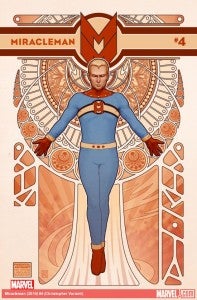After reading Miracleman issue four, I think I can safely say that I’ve found where this series hits its stride. The first three issues were full of good ideas with occasionally questionable execution. Here, the ideas are perhaps more interesting, compelling, and engaging in ways that make me even more excited for future issues. As far as execution, I find that there are relatively few negative elements to point out.Starting with the art, the book seems to have transferred from Garry Leach over to Alan Davis almost in its entirety. All four chapters in this issue that deal with Miracleman are drawn and inked by Davis, and Leach’s only contribution is what I’m calling a backup story featuring the Warpsmiths. I’m very glad that Davis is providing the primary covers for this series as it is both appropriate given that he produced the interior art and provides an interesting illustration of his growth as an artist. In previous issues, I remarked that I tended to prefer Leach’s art as it was more polished and compelling. That is still the case here but Davis is still producing great work which only seems to get better with each chapter. Comparing the cover to the interior art though, one can see how far Davis still had to come to attain his current mastery of the art form.Still, Davis utilizes very interesting and compelling panel layouts, and his art supports the narrative beautifully. I particularly like the use of silhouetted forms placed in a recurring position on the page to represent the government officials commenting on Miracleman’s actions. He also is not shying away from challenging angles and is drawing faces with increasingly compelling expressiveness and realism. Miracleman’s knowing, almost patronizing glance at Evelyn Cream and Big Ben’s tearful visage are particular standouts. I find it odd though that the art in the fourth chapter, “Saturday Morning Pictures,” seems to take a significant jump forward in quality. Lines are more polished and clean while there is a subtlety of facial expression here that is quite impressive. Perhaps this has to do with the fact that this chapter was produced in 1984 whereas the preceding three were produced in or prior to July of 1983, a gap in time allowing for this apparent improvement in Davis’ skills. At any rate, I very much hope to see more from him as the series progresses.
Miracleman #4: The Backstory [Review]
After reading Miracleman issue four, I think I can safely say that I’ve found where this series […]












